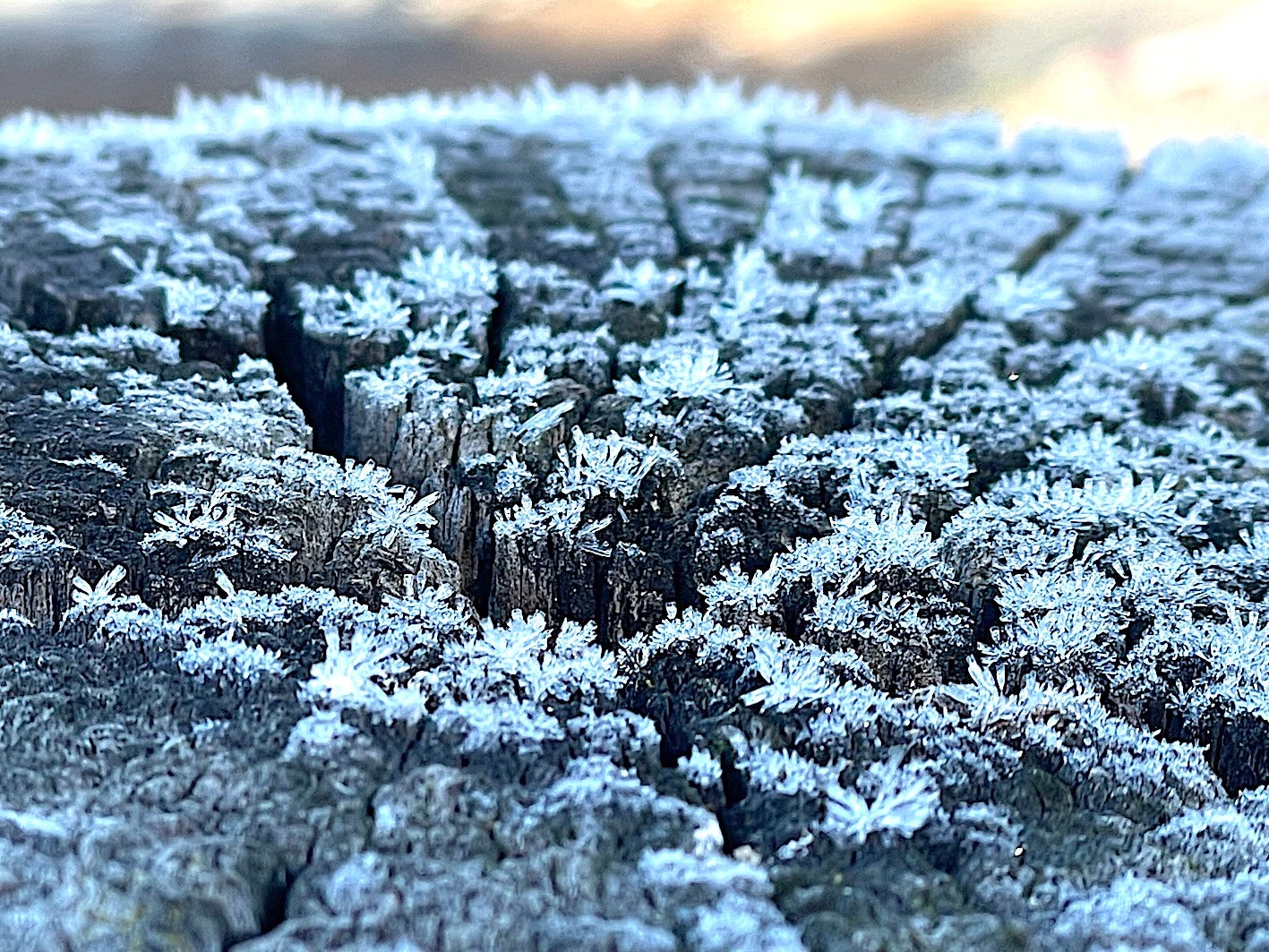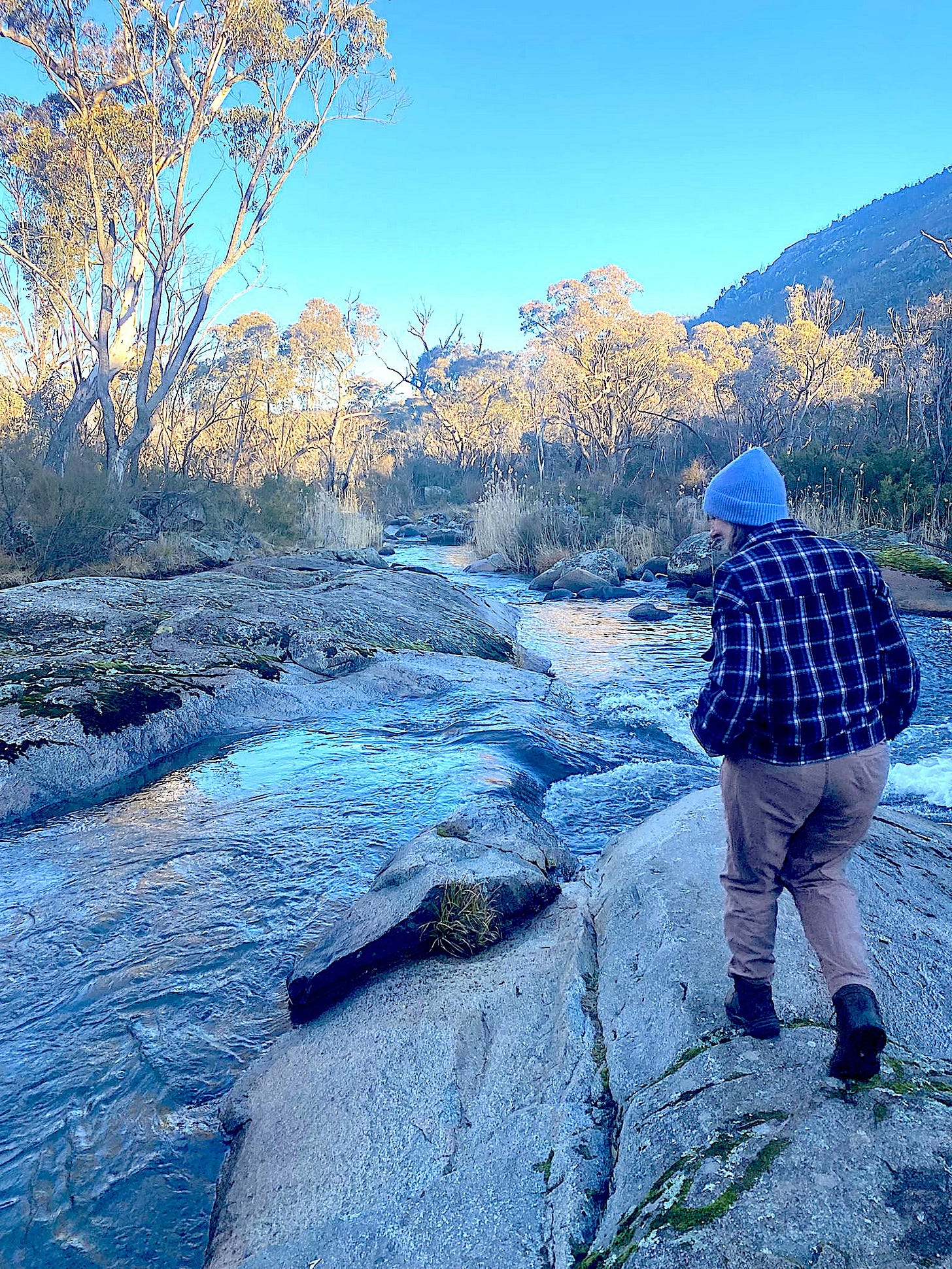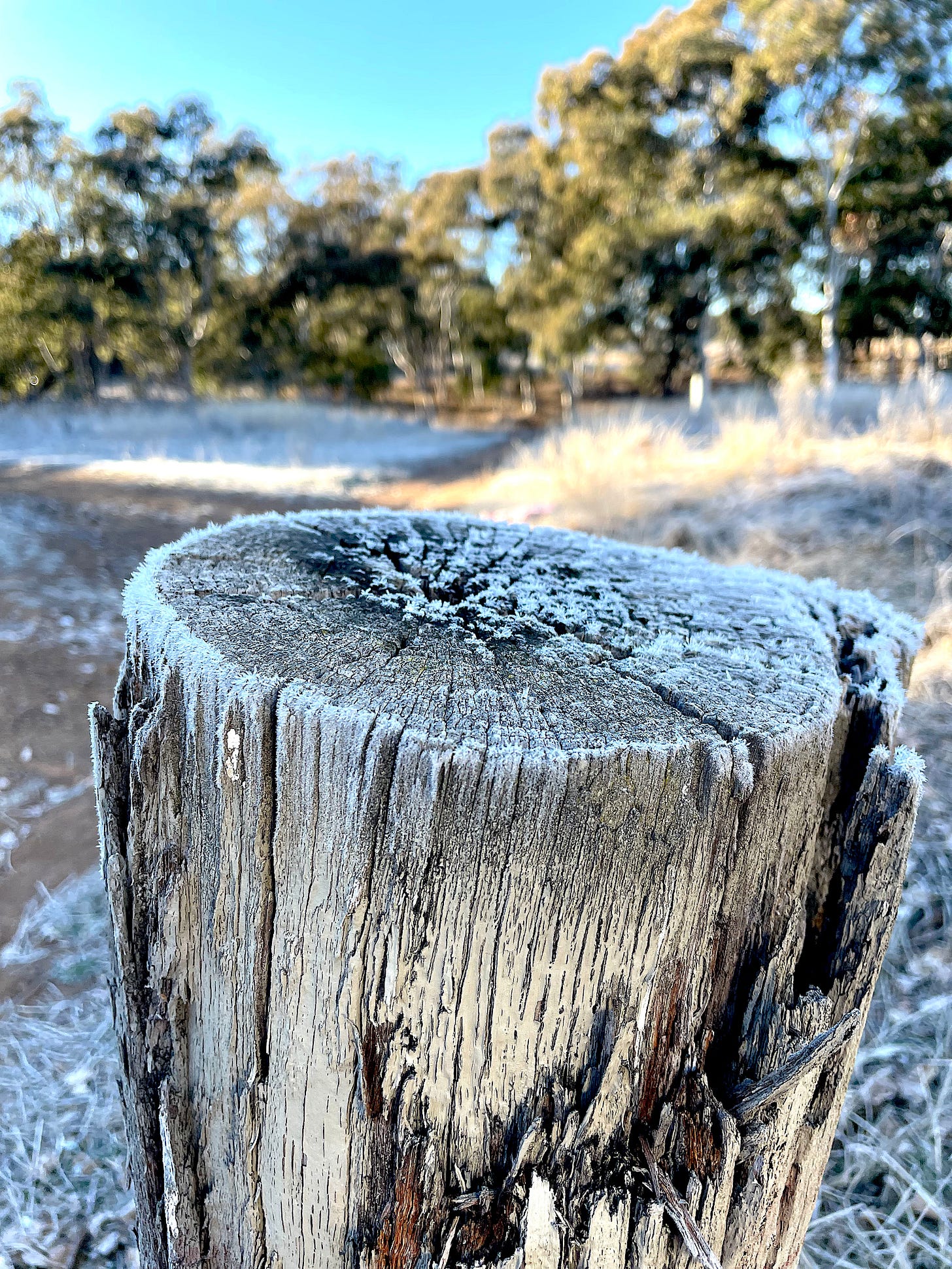34. On what can be learnt from frost
Or, how photographing frost helped me understand cybernetics, systems and myself
I want to show you frost

Frost is a simple way to share where I am now after a five year journey that led me into living systems and cybernetics. It took me to the commitment to learn about making better choices in the now to improve our futures. All of that sounds more complicated than frost. So let’s stick with frost, and see if any connections land.
I’m on a break from the intense pace of study. A perfect time to let go and process to allow the learning of cybernetics to happen. As a long time educator, I know it never happens in the classroom. It’s always outside in the ‘after’.
Lately, I’ve been doing a lot of walking around my neighbourhood, noticing the world around me, and thinking about how the ideas I’m learning — about systems, feedback, and change — show up in my everyday life and in the natural systems around me.
Just before I immerse you in some beautiful images, a quick explanation.
Cybernetics is, at its heart, the study of systems in motion. A cybernetic system has different components that are interconnected. These components communicate information around the system which creates change. The systems I’m interested in are open systems, which have feedback loops. These feedback loops can either strengthen and speed things up, or slow them down and cause the system to dissipate.
That is what led me to frost.
What frost reveals about the weather as a system
Although, as Australia’s political capital, it’s known for its hot air (haha), Canberra has actually been cold lately (brrr). The icy air slips in quietly as the sun goes down and forms its crystals over the leaves, fenceposts, grass and freezes puddles. I watch how it has formed, and then melt and evaporates in the early mornings here on the shady side of the hill I live on, up the top and in the valleys.
It is easy to think of frost as a simple event - just something that happens when it is cold enough. However, frost is not an isolated ‘thing’ that just appears.
It’s not just “cold weather” or “a cold night.” It only appears under a very specific set of conditions. For frost you must have:
Water vapour in the air — moisture must be present.
Cold temperatures — the surface must cool below both the dew point and freezing point 0°C (or 32°F).
Clear skies — without cloud cover, heat escapes from the ground, allowing surfaces to cool quickly.
Calm, still air — minimal wind lets cold air settle and prevents mixing with warmer air.
Cold surfaces — frost forms easily on surfaces that lose heat quickly, like grass, leaves, and cars.
Low-lying areas — cold air pools in valleys and hollows, making frost more likely there. Canberra is built in a “frost hollow.”
If you want to get a tad more scientific, check out the description in National Geographic.
Anyway, the more I looked at and photographed frost, the more I realised that, while we might think of frost as a thing that exists of itself, it’s actually the surface expression of a much larger system - the earth’s weather system.
What windy taught me about how systems grow and shift
I sometimes watch the mesmerising weather maps on Windy (here’s the link set on Canberra, if you’re curious). I can see how weather systems grow slowly, sometimes from almost nothing. A swirl of air or slight shift in temperature becomes a larger system, gathering speed and size. Some systems grow strong enough to dominate a region for days or weeks. Others fizzle and drift away.
Frost is an outworking of that. In a regional or site specific way it needs those ‘components’ I listed above, and some feedback from the environment. That swirl of air somewhere else, or a change in the air pressure nearby that means that requisite cloudless night will occur.
If you can think of frost not as a separate thing but as part of a system, you are well on the way to know what I’m talking about in cybernetics and even living systems. Frost is what happens when the system crosses a certain threshold. Stick with me now.
Thinking cybernetically about frost
In cybernetics, we often ask questions like:
Where is the system’s boundary?
What’s the systems purpose or goal?
What is inside the boundary? What components or elements are there, and how do they connect or interact?
What feedback is happening? It is enhancing the system, making it grow or go faster? Or is it a negative feedback loop, making it slow down or shrink.
When I look at frost through that lens, I see this.
Frost is not the system. The weather is the system. Frost is a visible output. Frost is feedback that there has been change in the system.
It is a signal that the system reached a certain point.
It tells us something about the night that is beginning or has just passed. It marks a moment in the system’s ongoing cycle.
And, like any feedback, it is not just passive. Frost can change what happens next.
It reshapes the ground temperature, which responds to the signal (great for growing tulips!)
It affects plants (as I said, tulips!), animals, even our routines and behaviours. What are you like on a frosty morning? It also triggers memory. I’ve had many conversations with people remembering frosty mornings from their childhoods, the “cold and frosty morning” part of the nursery rhyme to get children ready and hygienic for their day, and even tips for how to defrost your car windshield and not crack your water-pipes (a cloth over both might help).
Frost becomes part of the bigger loop.
In that sense, frost is not outside the system. It is part of the system continuing itself through new forms.
What is the purpose of a frosty night?
Writing a draft of this Substack last night had me wondering 'what is the purpose of a frosty night?'
Is it to reset the ground? To pause growth? To slow things down before they speed up again? Maybe it has no purpose we would easily recognise. But the goal (or function) of the whole weather system is to move heat and moisture around the Earth—constantly redistributing energy and balancing local climates.
But this is the real beauty of systems thinking, especially the slow, noticing kind I have been practicing: you get to zoom out and see the whole. When you do that, you can ask questions before you tinker with components and feedback. Sometimes (often) you can’t see the extent of the system, so you have to ‘sense’, ‘probe’ or ‘act’ to see what happens (feedback), then start to learn more about it.
Some systems start small. They build quietly. They leave a trace behind like morning ice, then they move on. Some may start small, but build with power and energy and are damaging to the other systems they run into (tornadoes, incendiary devices, Robodebt, colonialism).
Here’s the kicker.
We think we only deal with frost in isolation. We rug up to hose those windshields. Have covers and greenhouses to protect our plants. In Bacchus Marsh, in Victoria, there are even large fans (like these ones in the north west) to keep the frost off the veggies growing there.
But remember, frost is part of a system. If we wanted to seriously change frost, we’d need to zoom out and look at the whole system (or at least as much as we could make sense of). It’s the same for many other systems we’d like to change. Tinkering with the effects is only a topical solution. It might treat something small on that occasion, but not that whole system.
And in a way we have changed the system around frost. We have (on a global scale) triggered climate change. Ironically, it’s due to global warming that Canberra gets to keep it’s frosts as the cool season drying gives us more cold nights. Global warming in itself is feedback, which we have read and which has made us take action. Whether it is enough (I agree with those who say it’s not), that’s a discussion for another day.
When I look at frost, and see the system, I know I’ve progressed along on my mission to make choices with the generation of 2200 in mind. And you may well be too!
Where this all leads me now
As I’ve been sitting with this frost observation, I’ve also been reflecting on something bigger.
For much of my life, I thought my resistance to certain systems—my discomfort with how things were done—was just me being difficult, too sensitive, avoiding responsibility. I thought, and have had confirmed, often throughout life, that there was something wrong with me. In the culture I grew up in, there was a strong undercurrent of “this is just the way it is.” You put up with it. You suffer through it. Everyone around me seemed to do the same. A very few thrived, some survived, many didn’t.
And me? I was like frost. I was a beautiful formation at the borders of many of the other systems I encountered. Like the frost on the post or on the grass. There were times things looked good. All through my life I’ve had moments of confidence, knowledge, capability and beauty. My parents would breath a sign of relief, I’d get a good grade from school, or a brilliant new job. Then the sun would come out, or a hose would turn on and I’d melt. “Just getting on with it, over it, moving on, toughening up”, even just going to a doctor who recognised frost but didn’t help treat the conditions, was very unhelpful for my own system. I melted and had to wait to rebuild. Would we ever think of frost as weak or call it oversensitive when it didn’t withstand the dousing of the hose?
But now, through this process of deep systems work over the past five years, some of which I’ve described here in Towards Gen2200, I can see something else.
What I was doing wasn’t victimhood—I was in a quiet, persistent search for the right conditions for safety inside systems that felt unchangeable. To overstretch the metaphor, I needed to take my own action to move my frost butt to a colder place with better conditions so I could thrive.
Taken literally, that has represented a shift from Ballarat in Victoria, with all it’s meant for me over my adult life, to Canberra. Or even, closer to where I am today, able to live beside or inside unsympathetic systems, but ensure I have the internal systems strong enough to insulate me from the worst effects.
It won’t stop here. Less literally, and more factually, I’ve had to work to recognise the conditions for me: my own goal (that is my “goal”, not my “own goal”, though I’ve kicked a few); awareness and protection of the systems that serve me well, and discernment away from the ones which don’t, by going only to the places I’m invited into, and only when it meets my goal.
In these past few weeks, this semester break of looking at frost while letting new information settle, I can see - through imagination, metaphor, language and cybernetics and living systems - how clearly I’ve transitioned into the conditions which I will thrive in.
When I think about my brother, I can see he found his own space of safety early on. He built his own system with my sister-in-law. His challenges with the other systems have been different to mine, and many of his challenges, I’m sure, are invisible to me. It wasn’t easy for him either, but it shows me this truth:
If it was possible for him, over time it was possible for me. And if it’s possible for both of us, then it’s possible for others too. If it’s possible for others, it might be possible for many, many others. The right physical, emotional, relational, intellectual and environmental conditions will help us all thrive. Maybe that’s even you.
This is the heart of why I work on Gen2200, and why I stay focused on living systems.
If it’s possible for us to find a way to thrive inside difficult systems, without bypassing, without denial, then it’s possible for communities too. And if communities can shift, then the world can shift as well.
We don’t get there by force or in a rush. We get there by understanding the systems we’re in, starting with the ones closest to home - ourselves first, and then those around us; finding the spaces where we can create safety and clarity; then slowly shifting our own system, and in doing so those around us to be kinder, less damaging—not simply to us though that has to be our priority, for others, too.
I’m talking a lot now about my journey, but rest assured I’m far from perfect, and I don’t get off scott free. I’ve caused harm to others inside systems as well. Yes, true. I know I’ve done damage, just like others have done damage to me. Hard to accept, and to be honest this harm never fully stop. However, for me, the work, is now about noticing, choosing differently, and staying accountable to the system I’m shaping from here. I’m up for it. Are you with me?
Cool climate cyclone Jax
So, that’s where I’m at today. Feeling like I’ve managed to create a systeme of safety of nourishment for me to operate from. I will need to work hard to maintain that, and sometimes I will fail and have to reset.
The main this is that the frost was never just about the weather. It was an invitation to look at how systems work—quietly, subtly, and persistently—whether we notice them or not.
This is what emergence feels like. Small shifts, slow noticing, quiet movements toward something better.
Best always,
Jax

Your turn
I know this has been a long reflection. If you’ve made it this far, maybe the frost examination has stirred something in you too.
I’ll leave you with the same quiet question I’ve been carrying.
What kind of system might you naturally thrive in?
You could think about it in lots of ways. For example:
Intellectually — what kinds of ideas or ways of learning feel nourishing and expansive to you?
Environmentally — what physical environments support your wellbeing?
Culturally — where do you feel understood or at ease?
Food-wise — what types of food, eating rhythms, or practices suit your body and your life?
Sleep-wise — what kinds of rest or sleep systems keep you steady?
Relationally — what kinds of connections feel safe, generative, or joyful to you?
Energetically — what rhythms and activities match your natural energy cycles?
Physically — what kinds of physical spaces (even just your room or a favourite chair) offer you comfort and safety?
It doesn’t have to be complicated. You get to chose and build your system that suits and protects you from what you experiment with and get the feedback of what works (and what doesn’t).
Even just naming one small system that already supports you is enough to start noticing.
Imagine what you could do with your one precious life if you could cultivate your own system that helped you thrive. One gentle step at a time. It might take five years, it might take a lifetime. We all have a life time, and we all have some amount of choice, usually much more that we imagine.
NAIDOC week and acknowledge
Lastly, and importantly, it is NAIDOC Week—a week of celebrating survival and even thrival within the system of genocide and oppression that colonialism cloaked over the lands of Aboriginal and Torres Strait Islander peoples of Australia.
I acknowledge this, as I acknowledge the custodians of the lands I walk on to write and share stories like these here in Canberra - the Ngunnawal, Ngunawal and the Nambri peoples. I pay my respects to First Peoples everywhere—to their Elders past and present, and to any Indigenous readers here today. This land is sovereign and was never ceded.
—Best,
Jax
📢 Want more?
📖 More Jax insights on Medium and LinkedIn
📸 My photos— Flickr







What beautiful photos Jax. I loved this reflection - both the concept of something 'small' like frost being part of a much larger weather system, and your reflections on your own systems.
It's easy in a city to not think much about weather, to view rain (or frost) as an inconvenience to be managed around. It takes time to remember that without the water cycle, there can be no life, no food, no humans. And frost and rain are integral to that cycle. The fact that we have these is a blessing!
As to your own systems, I highly relate to the idea of thinking there was something wrong with me when I didn't thrive in the environment I found myself in. I too am challenging those thoughts and seeing how my own best self relates to others and the places around me.
I love calm people and need time to read, percolate, and breathe to offset the environmental pressure to rush around and be mentally stimulated.
thanks as always for sharing your thoughts.